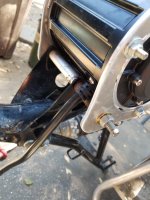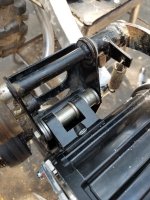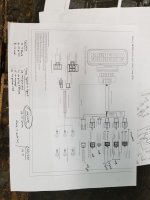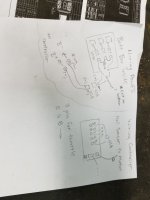Taysluppy said:
Well I looked at a few of the threads and I realize that that question looks to be annoying at this point haha.
It's not that it's annoying, it is that it is impossible to give a relevant answer without enough information (but many people refuse to give sufficient info even when asked specific questions

and sometimes even get upset when we can't help them without it).
When I thought of this build originally I wanted it perform just as well as a gas powered 125cc. Speed and power wise at least.
What performance does the specific bike you have in mind give you? They don't all respond the same, as even with the same engine size there are different weights, designs, gearing, etc.

It will be used in hilly terrain with gradients varying from 0 - 7 %. Mostly dirt and some paved road travel. I would like the bike to at least reach 25mph (more would be better) and also still have the power to move my 160lbs rump uphill and on flat ground. I want it to run forever but I'd be happy with 15 to 20 miles. If I could recharge the battery in a few hours that would be a plus as well.
Reach 25mph on the flats, with no wind? Or reach 25mph on that 7% hill with a 20mph headwind? Big difference in power requirements for those.

Also, do you care if it takes you half a mile to get to 25MPH, or do you want to do that "instantly"? Again, power requirements are different.
The simulator at http://ebikes.ca/simulator can help you see what I"m talking about, even though it's oriented toward bicycles, you can still see the differences by setting up a system and a situation and looking at the results you get, even if it's not the same as your system.
Basically, 25MPH you can do with less than 1000w on the flats with no wind. Her'es a simulation with a hubmotor on a bike similar in setup to what you have, guesstimate 300lbs total with motor/battery/etc on there. I limited the controller to 27A because that's what 2000w at 72v would give you, and 35A phase, as those are the limitations placed on the motor specs you gave below. (so this assumes the controller has been reprogrammed to limit to those).
https://www.ebikes.ca/tools/simulator.html?motor=MCRO5004&batt=B7223_AC&cont=cust_27_35_0.03_V&hp=0&mass=140&wheel=12i&axis=mph
This particualr motor in a 12" wheel happens to give 24.5mph at around 700w battery power, but your actual speed would be dependent on your motor's RPM vs gearing ratio to wheel vs wheelsize. I didn't make the sim that complex.

If I add in a 7% slope, it gives about 22mph, and takes about 1600w or so.
Add a 10mph headwind and that drops to about 20mph, going up to about 2kw.
Make that 10mph and speed drops to 16mph, but power is the same because it's already hit the ocntroller limits.
If I set the sim up for yoru actual controlelr limits, then with a 20mph headwind up that hill, it's this
https://www.ebikes.ca/tools/simulator.html?motor=MCRO5004&batt=B7223_AC&cont=cust_130_400_0.03_V&hp=0&mass=140&wheel=12i&axis=mph&wind=-40&grade=7
and only 16mph takes about 2600w battery power, which is about 2300w at the motor (300w of power lost as heat in the system). It takes about 130wh/mile for this.
No headwind and just the hill is 22mph, 1600w battery, and about 72wh/mile.
Flat ground and no wind is almost 25mph, 700w battery, and 29wh/mile.
10mph headwnd flat ground is 23mph, 1200w batery, and 52wh/mile.
Since those aren't for your specific motor and your drivetrain type, I played with the middrive option and a custom motor setup at 38kv (per the calculations a few paragraphs below), and get this:
https://www.ebikes.ca/tools/simulator.html?motor=cust_38_0.12_0.2_23_0.77_0.0185_95&batt=B7223_AC&cont=cust_27_35_0.03_V&hp=0&mass=140&wheel=12i&axis=mph&grade=0&wind=0&mid=true&gear=1&kv=38&tr=10&tf=78
that has almost 25MPH on the flats, but requires a 78tooth *front* sprocket, and a 10T rear sprocket, which is probably not very practical. But I'm pretty sure I'm using it wrong, because that's the opposite of what I expect to have to setup, and the sim gives negative motor watts and nothing like the correct curves on the chart. :/ I'd have to go back and read all the instructions below the sim to figure out what I'm doing wrong.

But hopefully you get the idea.
OK, now for battery stuff, based on the above. If it takes about 2.2kw battery power at most, say 30A, and 70wh/mile is about average usage (between flats and hills, if there's more hills it'll go up and range goes down for same battery size), then to get around 20 miles out of it you need 20 * 70 = 1400wh, or 1.4kwh. For a 72v battery, that's about 20Ah (1400/72). If you want more range, you add Ah--in your case it works out to around 1Ah per mile if that power usage is correct--more hills, more Ah needed.
If it only has to supply about 2.2kw, at 72v that's around 30A, whcih is only about 1.5C (c-rate is current-delivery ability of a battery, in multiples of it's capacity), which pretty much any decent battery can do. If there are situations in which it has to supply taht whole 7200w, then 7200 / 72 = 100A, and that's a 5C battery needed, so you need a better quality battery with better cells, BMS, etc.
Keep in mind that sellers lie, so they can sell things. (they dont' have to, but they think they sell more when they lie, so they do it). Some lie more and worse than others, and some lie by omission rather than explicitly, but you can assume that none of them tell the full truth. When you run across one that actually does tell the whole truth, then you can be pleasantly surprised, but at least you won't be shocked by what you get when you buy from any of them if they overrate their stuff.

So, if a seller tells you something can provide 100A, assume it can do 50A, and that if it says 20Ah, you'll get 10-15Ah. (when it's new--as it ages, it gets less capable, and the harder it is used, the faster taht will happen).
The bike itself (2005 Xtreme 125cc) with motor removed, I want to say, weighs about 80lbs. It has 3.5 x 12 inch wheels front and rear. I want to say its roughly 60 inches long. Idk if thats needed. Its just a small pit bike.
The wheel size is important, because it affects both torque and speed for whatever gearing you use. If you're not using gearing from a frame-mounted motor, but rather a hubmotor, then it directly affects which motor you need, and what voltage you need, to reach a specific speed, and how much torque you get from that motor with a certain amount of current.
What size sprockets do you have on the rear wheel, and on the motor? You have to use those to determien the gear ratio, and thus the RPM at the rear wheel, to determine the speed of the system. If you don't have the right gearing, you are either gearing for too high a top speed, which means using more power than you need to and getting less torque than you could, or not even being able to reach the top speed you need.
The motor I purchased is a QS Motor 120 2000w Mid Drive and it has a 428 sprocket:
Power Rating: 2000w
Voltage: 72v
Rpm: 2800 without Flux and 4400 with Flux
89% Efficiency
Speed: 70 kph
Continuous Current: 35A
Peak Current: 60A
Peak Phase Current: 250A
Net weight: 10 kg
FWIW, the "70kph" is irrelevant, because what speed you get out of it is dependent on the voltage you use on it, the total power you have available to run it, and the gearing between it and the road (including wheel size). What they *should* provide is the kV of the motor, it's RPM per volt. *that* would be useful. If the 2800RPM they say is at 72v, then you can calculate the kV as 2800/72=39kV, or 38RPM for each average volt fed to the motor. That means at 48v it would only be able to spin, maximum, at 39 * 48 = 1867RPM.
The continous current and peak current don't make sense, with a peak phase current. It needs to have a continous phase current rating to go with the peak one. The other currents sound like battery currents, and have nothing to do with the motor currents. So you may want to ask QSmotor exactly what those specs mean. If they are actually phase currents as well, they sound pretty low.
The controller it came with is an EM100SP:
Rated Current: 100A
Boost Current: 130A
Peak Current: 330A
Max Power: 7200w
Flux Ratio: 100 ~ 250%
Efficiency: 88 ~ 93%
Weight: 1650 g
FWIW, that could overheat your motor if you actually use anything near it's capabilities continously, meaning if the loading your rides put on the motor can draw that much power (probalby not, but...). Unless the motor is severely under-rated by the manufacturer at that 2000w, it doesnt' have the ability to shed the heat that the about three-and-a-half-times more powerful 7200w controller could supply it.
It *is* common to be able to give bursts of power to a motor that are much higher than it is "rated" for, but doing it too long overheats them, and overheating eventually damages things (anything from epoxy holding magnets in place, to the windng enamel, to hall sensors, to the actual magnets). So you have to be careful and keep an "eye" on it.
If you don't have a wattmeter and a temperature sensor, I'd get those to build into the bike first thing. Then you can keep an eye on motor temperatures, and if they get too hot you can reprogram the controller if it's capable of that, to limit it's power. If it can't be programmed, then you'd just have to keep an eye on motor temperatures and limit your throttle hand to keep it in check.























